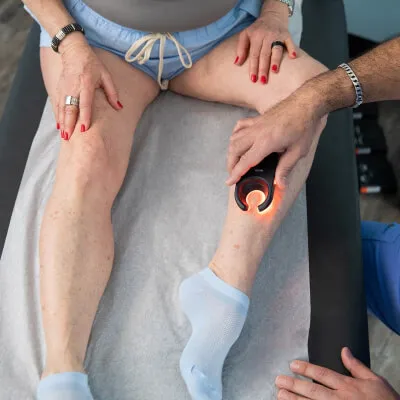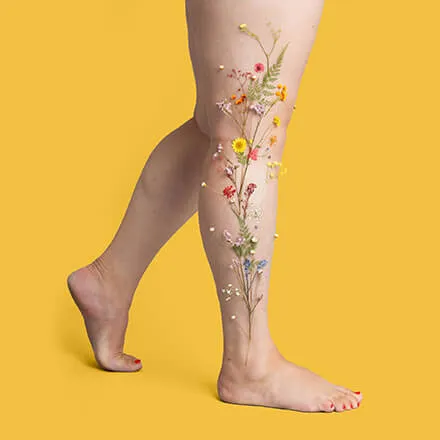Varicose veins is a common condition that if not treated, can cause not only cosmetic concerns but also discomfort. One of the symptoms associated with a diagnosis of varicose veins is varicose vein bruising, which can lead to additional issues if not addressed. Let's explore the causes, prevention strategies, and treatment options available to help you address varicose veins and prevent varicose veins bruising from occurring, so you can enjoy healthy, happy legs.
What Is Varicose Vein Bruising?
Bruising, in the context of varicose veins, refers to the skin discoloration that develops when fragile, dilated veins leak small amounts of blood into the surrounding tissues. This can happen when the veins near the skin's surface burst and bleed into the surrounding tissue, resulting in a bruised appearance or dark or patch on your skin.
Unlike typical bruises from a blunt impact, bruised varicose veins can occur as a result of minor trauma or even normal daily activities. This is because varicose veins have weakened walls and are more susceptible to damage and blood leakage.
Vein Bruising Causes
Varicose vein bruising develops as a result of extra pressure on weakened veins near the skin. The walls of varicose veins are thinner and less elastic, making them prone to rupture. This results in bleeding in the surrounding tissue, leaving a darkened area on your skin.
Minor Injuries and bumps can also cause vein bruising. Even slight impacts that wouldn't cause bruising in healthy veins can lead to leg bruising when varicose veins are at play. In some cases, the simple act of walking or moving can cause enough stress on weakened veins to result in bruising.

Risk Factors and Who's at Risk
There are certain genetic and lifestyle factors that can increase your risk of developing varicose veins and bruising. These include:
- Age: As we age, vein walls naturally weaken.
- Family History: Genetics play a significant role in vein health and disease.
- Obesity: Excess weight can put added pressure on veins.
- A Sedentary Lifestyle: Lack of physical activity can contribute to poor circulation.
- Prolonged Standing or Sitting: Long periods of immobility can place you at increased risk.
Symptoms and Warning Signs of Varicose Vein Bruising
Sometimes it's difficult to tell the difference between a regular bruise and a varicose vein bruise. However, there are a few key differences to help you determine whether the bruising you observe is normal or is cause for concern. Telltale signs of varicose vein bruising include:
- Dark discoloration (blue, purple, or brown) around varicose veins.
- Tenderness or pain in the bruised area.
- Swelling in the affected leg.
- When bruising does not get better over time.
It's very important to know the difference between normal bruising and signs of an underlying issue. If bruising is excessive, accompanied by unusual pain, or doesn't improve, you will want to consult with your vein care specialist as soon as possible.
Risks Associated with Varicose Vein Bruising
When varicose veins are left untreated, they may progress to chronic venous insufficiency, which can cause significant symptoms. Likewise, there are a number of risks associated with varicose vein bruising, which is why it's important to seek medical attention if you develop the signs and symptoms of the condition. These include:
- Venous Ulcers: Venous ulcers are pen sores that don't heal on their own.
- Blood Clots: Blood clots, including deep vein thrombosis (DVT), are a potentially dangerous risk associated with varicose veins.
- Bleeding: A ruptured varicose vein can cause bleeding.
Diagnosis and Evaluation
An accurate diagnosis by a vein specialist is necessary to rule out varicose vein bruising. To determine whether your bruising is caused by varicose veins, your doctor may perform one or more of the following diagnostic tests, which help identify to the extent of vein damage and any underlying conditions:
- A Clinical Exam: A vein health evaluation to visually assess the veins and surrounding tissues.
- Ultrasound and Doppler Studies: To assess the circulation of the veins in your legs.

Varicose Bruising Treatment Options
The goal for treating both varicose veins and any potential complications associated with the condition is to alleviate symptoms and improve your overall vein health. Your vein doctor can advise you best as to your treatment options, which may include:
Conservative Bruising Remedies
- Compression therapy/stockings
- Topical remedies to soothe discomfort
- Ice packs to the area to relieve pain and swelling
- Elevating your legs
Medical Treatments
- Sclerotherapy to close off damaged veins with a concentrated, injectable foam.
- Radiofrequency Ablation (RFA) is a quick radio wave-based treatment that emits heat for large, unhealthy varicose veins. RFA usually takes 15-30 minutes in an outpatient setting.
Lifestyle Changes
- Regular exercise to improve circulation.
- A balanced diet to maintain a healthy weight.
- Proper skin care to minimize irritation.
- Home care tips to help reduce swelling.

Prevention and Long-Term Care
Preventing varicose veins and bruising involves the diagnosis and treatment of any underlying vein issue by a board-certified vein specialist. In addition to recommended medical treatment, you can manage your symptoms by maintaining the lifestyle changes recommended by your vein doctor and scheduling regular check-ups for early detection and intervention.
Conclusion
Varicose vein bruising can be managed by treating any underlying vein disease. Your vein doctor will discuss the best minimally invasive procedures available to you, so that you can take proactive steps toward healthier veins.
Are you worried about varicose veins or vein bruising? Schedule a consultation with our vein specialists today for a free evaluation to go over all your treatment options and protect your vein health!
Frequently Asked Questions
What causes bruising specifically in varicose veins?
Varicose vein bruising is caused by fragile vein walls and blood leakage from minor trauma.
Is varicose vein bruising a sign of more serious venous issues?
Yes. Varicose vein bruising can indicate more serious varicose vein complications due to underlying vein disease.
How can I prevent or reduce bruising associated with varicose veins?
While the only cure for varicose veins is an approved vein treatment under the care of a vein specialist, lifestyle changes such as regular exercise, a healthy diet, and compression stockings can support your healing and recovery.
What treatment options are available if varicose vein bruising worsens?
Medical treatment options for varicose veins include sclerotherapy, RFA, and Varithena.
When should I see a doctor about bruising on my varicose veins?
You should consult with your vein specialist when bruising is associated with varicose veins and is accompanied by pain or doesn't improve.

Dr. Jendy Amelio
Meet Jendy Amelio, MD, a highly-rated doctor specializing in the treatment of vein conditions. Schedule an appointment in TX today.
Meet Dr. Jendy Amelio
Trusted insight from the nationally accredited, board-certified vein doctors at Metro Vein Centers.







